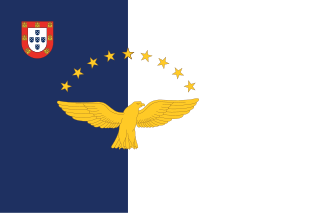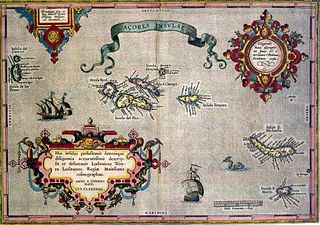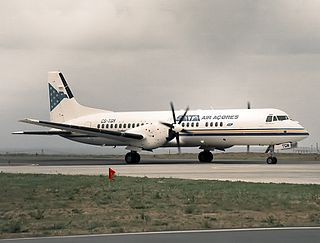History

First World War
The city of Horta was bombarded in December 1916, and the following year the city was shelled by the German U-boat SM U-155 on 4 July 1917.
With the U.S. entry into the First World War the previous year, American naval forces occupied and operated a naval base in Ponta Delgada, consisting of a few Curtiss HS2L hydroplanes, 150 infantrymen, two pieces of artillery, some ships and submarines. The first of the contingent began patrolling on 23 February 1918, alongside the São Brás Fort in Ponta Delgada. Their mission was to identify and combat German submarines that tracked merchant shipping in the Atlantic, and protect the waters of the Azores.
Even during the conflict, and following its events, the Portuguese Navy already projected the installation of a permanent naval air station in Horta (Portuguese : Centro Aero-Naval), which never materialized. Similarly, in 1919, the British Royal Air Force planned the possibility of acquiring one of the Portuguese islands in the Azores, to install a terrestrial base to provide support to air operation in the mid-Atlantic.
Interwar period



During the inter-war years, trans-Atlantic competition persisted between British and American entrepreneurs; the London-based Daily Mail promoted a competition worth £10,000, to the aviator who was able to cross the Atlantic non-stop, within 72 consecutive hours, between the United States, Canada or Newfoundland to any point in Great Britain or Ireland. [1] [2] In this context, three four-engine hydroplanes of the American Navy attempted the first non-stop trans-Atlantic crossing between 16–17 May 1919. Two of the planes (NC-1 and NC-3) made emergency landings near Flores: NC-1 was completely damaged, while the NC-3 was able to continue to Ponta Delgada (by 19 May), but unable to complete the journey. NC-4, under the command of Lieutenant-Commander Albert Cushing Read was able to survive the attempt, stopping in the Bay of Horta on 17 May, and continuing to Ponta Delgada (where he stopped on 20 May). After a week of rest, the team left on the morning of 27 May in the direction of Lisbon, arriving in the capital in the evening and anchoring in the Tagus River.[ citation needed ]
Still in 1919, a hydroplane travelling from England to the United States stopped in Faial, which became a frequent occurrence over time, utilizing Horta as a stopover.[ citation needed ]
With the advent of commercial dirigibles, the archipelago was over-flown in 1924, 1927 and 1930, by Zeppelins making the connection between Germany and the United States.[ citation needed ]
In April 1926, a Fokker hydroplane, baptized Infante de Sagres, departed from Lisbon, under the command of Portuguese Navy pilots Moreira de Campos and Neves Ferreira, intentionally to connect Madeira and the Azores, arriving in Ponta Delgada on 9 May 1926. [3]
Following this first flight, in 1927, the Marquess Francesco De Pinedo, colonel in the Italian Air Force, was forced to ditch his plane 200 kilometres from the island of Flores, after departing Newfoundland. The Savoia-Marchetti S.55 hydroplane, named the Santa Maria II, was recovered and arrived in Horta, where it was repaired. [4]
Later that year, in October/November, a Junkers G 24 (D-1230) [5] and a Heinkel (D-1220) [6] hydroplane stopped off in Horta, where they encountered American aviation pioneer Ruth Elder, who was trying to emulate Charles Lindbergh's feat. Piloting a small monoplane, that she named American Girl, and accompanied by Captain George Haldeman, she was forced to ditch her plane in the waters along the north coast the island of Terceira due to mechanical problems, and the aircraft caught fire. [7]
In June 1928, English pilot Frank T. Courtney, piloting a Dornier Wal G-CAGI, [8] and later in July, a French Lieutenant in a small hydroplane named La Frégate, stopped in Horta on their trans-Atlantic flights.[ citation needed ]
In Graciosa, on the morning of 13 June 1929, an Amiot 123 biplane overturned during an attempted emergency landing in some fields near Brasileira. The plane, piloted by Polish aviators Major Ludwik Idzikowski and Kazimierz Kubala had departed early that morning from Le Bourget field, in the suburbs of Paris, as part of their first trans-Atlantic crossing, heading for New York. Idzikowski was killed in the accident and Kubala suffered minor injuries, while the plane was consumed by flames during the rescue, when someone approached the wreckage with a torch. A cross was erected to mark the location of the accident.[ citation needed ]
The following year, the Portuguese armed forces supported the idea to construct an airfield on the island of Terceira. On 4 October 1930, the first mono-motor Avro 504K biplane called the Açor, piloted by local Frederico Coelho de Melo departed from the 600-metre-long and 70-metre-wide runway. [9]
Between 1930 and 1933, the American Pan American completed tests in Horta bay as part of their plans to operate trans-Atlantic routes between North America and Europe. In this context, Charles Lindbergh (accompanied by his wife Anne Morrow) in service of Pan American, landed on 21 November 1933, with his Lockheed 8 Sirius monoplane. After these tests, between 1937 and 1944, Pan America's Flying Boats (Boeing 314 Clippers) routinely made the New York–Marseilles and New York–London routes with stopovers in Lisbon. The New York–London leg of the flight had a 23-hour-and-55-minute duration, and included a one-hour-and-thirty-minute layover in Faial, while the Lisbon–Marseille route consumed an additional seven hours. [10] [11] The use of Faial as a technical layover was also used by other companies, who used the waters between Faial and Pico on stopovers between North America and Europe.[ citation needed ]
In April 1931, during the Azores Revolt[ clarification needed ], three small hydroplanes of the Portuguese Navy used Horta as a base to overfly Angra do Heroísmo and Monte Brasil. These planes dropped pamphlets onto the island in order to convince the mutineers to surrender.[ citation needed ]
In 1933, a squadron of 24 hydroplanes commanded by Italo Balbo arrived in the archipelago: nine landed in the port of Horta, while the remaining continued onto Ponta Delgada, where one was lost en route.[ citation needed ]
A year later, on 19 May 1938, a comparable squadron of four tri-motor aerial reconnaissance Bréguet 521 Bizerte of the 1st Atlantic Light Squadron landed in Ponta Delgada, before one continued on to Horta and another to Angra do Heroísmo. [9]
Second World War

With the outbreak of the Second World War, the Portuguese Navy finally established a permanent Air-Navy Centre in Ponta Delgada. At the same time, a military aerodrome was established at Santana, in the civil parish of Rabo de Peixe, in the municipality of Ribeira Grande. Located on the northern part of the island, it operated as a military installation during the War, when it was known as Base Aérea No.4. But, by the spring of 1941, António de Oliveira Salazar began to believe that Germany, or its allies, would completely overrun the Iberian Peninsula. As a consequence, the Estado Novo regime pondered the withdrawal of the Portuguese government to the Azores, with the support of Britain. It was in this context that an Anglo-Portuguese working group was established to study and design the construction of new airfields in the archipelago. But even as the fear subsided, British prime minister Winston Churchill believed that new installations would be essential in the control of central and southern supply routes in the Atlantic Ocean, as well as supporting Allied forces operating in North Africa and the Mediterranean Sea. The construction of air-sea bases would close the Azores Gap, and provide a secure blanket for the North Atlantic. The sudden attack at Pearl Harbor by Imperial Japanese forces resulted in a review of Portuguese guidelines, paralysing the working group.[ citation needed ]
A ship (the Portuguese Mirandela) shipped 30 Gloster SS37 Gladiators and five Junkers Ju 52 monoplanes, as well as support equipment and personnel, were sent to the Azores (departing on 4 June 1941). Fifteen of the Gloster Gladiators and five Ju 52s were deposited in São Miguel at Air Base 4, for the 1st Expeditionary Fighter Squadron, while the remaining planes were sent to Terceira to form the 2nd Expeditionary Fighter Squadron. At the same time, the British sent to São Miguel 12 Curtiss P-36 Hawk, to constitute the 3rd Expeditionary Fighter Squadron.[ citation needed ]
But, the Achada Airfield in Terceira suffered from periods of fog, which covered the area during most of the year. This meteorological problem, forced the relocation of air operations to the plain of Lajes, where they constructed a new runway.[ citation needed ]
After long negotiations, an agreement was established between Portugal and Great Britain (1 August 1943), which conceded the facilities at Air Base 4 and Lajes for use by British forces to base their North Atlantic anti-submarine patrols. In exchange, the Portuguese received six squadrons of Hawker Hurricanes. By this time, in 1942, Humberto Delgado was appointed Air Force representative to the Anglo-Portuguese working group. Conscious of the geostrategic importance of the Azores to trans-Atlantic flight, Delgado recommended to Salazar that one of the two air bases (Santa Maria or Lajes) should be converted into a trans-Atlantic airport and centre for air traffic control, while noting: "If Your Excellency wishes to decide [which airport], I would say Lajes will do, but everyone, even the British, consider Santa Maria better". [12] For his efficiency in the commission, the British government, decorated Humberto Delgado with the Order of the British Empire, since the officer had risked his career and future on the Allied cause. Between 15–18 May 1943, the Trident conference to approve an Allied strategy on the Azores. It was followed by the Quebec Conference between August 11 and 30, in which U.S. President Franklin D. Roosevelt and the British Prime Minister agreed that Great Britain would enter the Azores with Portuguese authorization, followed by the United States, two weeks later. On 10 September, a combined British force, under the command of Air Marshall G.R. Bromet, departed from Liverpool in the direction of the island of Terceira. [13]
British forces disembarked on 8 October 1943, at the Port of Pipas, in Angra do Heroísmo, and a contingent of 3000 soldiers travelled to Lajes in begin expanding the small aerodrome in the area called Terra Chã. Before the end of the year, the 235 Squadron of the Royal Air Force's Coastal Command was able to sink a German submarine using its contingent on Terceira. By the beginning of 1944, 1400 U.S. troops and 1700 tonnes of equipment had also arrived in Angra and Praia da Vitória, in order to expand and reinforce the runway at Lajes. This included the 928 Engineering Regiment of the U.S. Air Force (17 January), and the 95 Battalion of the U.S. Navy's Seabee construction corp (19 January). Later the US authorities signed an agreement to construct an aerodrome on the island of Santa Maria (28 November 1944). This was done under the guidance of Pan American airlines, as the Portuguese, not wanting to arouse the wrath of Nazi Germany, only accepted the project on the grounds that it was a civilian facility. The construction began in 1944, in conjunction with the erection of a company hospital that served to provide medical assistance to U.S. troops hurt in the European theatre of operations.[ citation needed ]
At the end of 1946, the aerodrome in Santana was converted into a civil airport, with two grass fields (one with a 1500-metre runway and the other 100 metres in length). The local population, owing to its rural location, on prime agricultural location, resulted in its local colloquial name as aerovacas, since cattle grazed on the land when flights were not occurring. Ponta Delgada-Santana field was a regional airport at the time, and international services were directed to the international airports in Santa Maria or Lajes Airfield.[ citation needed ]
Post-World Wars

But, the inauguration of the Ponta Delgada-Nordela Airport on the southern coast of São Miguel island, fronting the main population centre, on 10 August 1969, changed the face of regional/international services in the Azores. Since its inauguration the Nordela Airport served as the operational base of SATA Air Azores and, two years later (in 1971), TAP Air Portugal began to provide regular flights between Lisbon and Ponta Delgada.
By the start of 1970s, 2 more aerodromes were constructed on other islands in the archipelago:
- on 24 August 1971, a new airport in the civil parish of Castelo Branco along the southern coast of Faial was inaugurated; and
- in 1972, Flores Airport was constructed on the eastern coast of the island of Airport to support the neighbouring islands of Flores and Corvo.
In 1976, following the fall of the Estado Novo regime, in an era that was tumultuous, the democratic politicians debated a proposal in Portuguese National Assembly to regionalize the provision of services to the Azores and Madeira.
Following these events, the increasingly autonomous governments of the Azores, between 1981 and 1983, built several airports to provide expanded service to the remaining islands. In addition to improvements at Horta Airport, the government of the Azores finalized construction of:


















